We continue acquaintance with Technopark Skolkovo

“Ural” is the first of the buildings of the Skolkovo Technopark.
My last visit to Skolkovo caused a certain response in Habré, including the administration of the technopark, due to the fact that the review turned out to be rather one-sided and amateur. Yes, this is my IMHO, but the problem is that this is generally the only blogger article on Technopark on Habré, and in the whole runet.
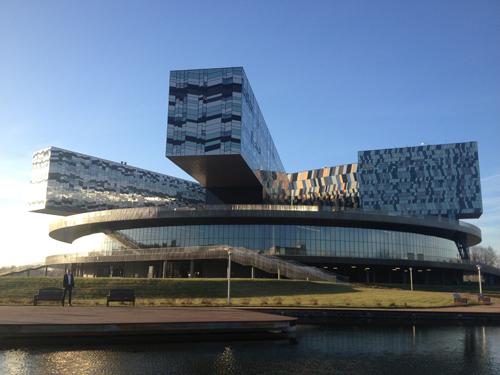
Directly opposite the "Ural" - the space building of the business school "Skolkovo"
')
It is necessary to correct the situation - but how to tell about the technopark objectively? Probably only through the history of its residents. When I walked through the technology park, I met two projects - a platform for communication with genetic consultants. PrimerLife and Indoorgo building navigation system. I also asked TsarS to review the Skolkovo catering - we will do it the next time, as soon as I go around all the establishments.
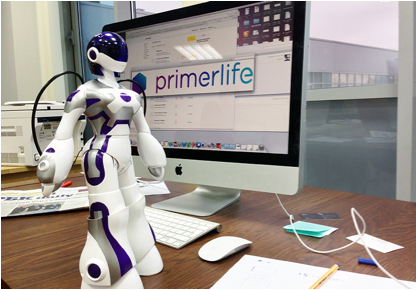
Workplace CEO.
I stumbled on the PrimeLife accidentally - I went to look for residents in the "Ural" and started from the last floor - the left wing was empty, and only in one room I heard laughter mixed up with discussion of some news on gene therapy. So I met Sergey Museenko.
A year ago, he worked with Anna Trunina at the MIPT Innovation and High Technology Center on a project to develop “biodegradable bilar stents for the bile ducts” - these are patches for damaged vessels that decompose when the injury grows.
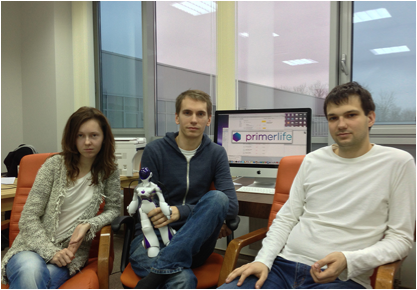
Startup Guide And all they have eleven people in the team.
But at that time he dreamed about studying at Singularity University - this is his own university of silicon valley with all the consequences - all the founders constantly read their lectures there - from Nasa to Google, plus you immediately get into the crowd and get into the inventive spirit. One drawback - studying in it costs from $ 25,000.
But less than a month later, as Sergey, an invitation to the “My Idea for Russia” competition from the Skolkovo Open University unexpectedly came to the post office. Under the terms of the competition, it was necessary to write a detailed resume with their leadership experience, study and propose a project how to change the lives of five million people in five years. All per thousand characters.

Anya offered stents, and Sergey - a genome-based social network. Both won and following the results of skype-interview with professors of the University of Singularity, both were enrolled in the course. Biotechnology is the only branch of knowledge for which the USA is now sparing no money, and even in a crisis, financing was cut for everyone except biotech.
As a result, Anya and Sergey not only won training, but also received a grant from Skolkovo for 3 million rubles. Becoming residents of Technopark PrimerLife received an office, management assistance, patent support, international advertising and, most importantly, a chance to do everything as they want.
In 2003, the human genome decoding project was completed. You must have heard about him, but his value turned out to be a mystery. In public opinion, the opinion was fixed that it was “deciphered” loudly - scientists just received the ACTG code and now they will find out for decades what and what parts of the code they are doing. But think about it - for the first time we received the source of a person as a computer program.

James Watson, along with Francis Crick, who understood the purpose of the DNA molecule, once said: knowledge of the human genome will change the world just as the typing press changed it. We will be able to check the accuracy of this forecast in our time.
Genetics as a science began with a study of the heredity of peas and Mendel's experiments, and only 200 years later we got to the sources of the life we studied. A person is encoded by three billion nucleotide pairs. They set everything and the physical structure and even the behavior and way of thinking. But this is not much more than the amount of windows xp source code, which has 40,000,000 lines of code.
At the same time, the DNA code is extremely interesting in itself, it is entangled hundreds of times worse than the blackest “Hindu code” - some elements launch other sections of the code when they are compiled, they block the third sections, while others block the first one. Separate programs also participate in the process in an unknown way - “junk dna”, “supporting proteins”, pseudo-DNA, etc.
If in 2003 the price of DNA decryption exceeded the height of Everest, by 2012 the equipment for gene experiments dropped in price to the level of household appliances. At one time, more than a trillion dollars was spent on the human genome project, now $ 300 is enough for the simplest genetic analysis. In Moscow now the same amount of analysis for one of the hundreds of the most common diseases.
Moreover, dozens of large-scale studies of genotypes have already been carried out - scientists collected samples from hundreds of thousands of people around the world to identify communities. Studies have yielded so many accurate results that it turned out - we have a laborious, but simple way to determine all human predispositions with almost complete accuracy.


Listing of the human genome code, page 32813 (fragment)
Spit in a test tube, you will learn what dangers with health can be expected of you. If you give these data to a geneticist, he will be able to prepare accurate recommendations for you on how to avoid health problems. This is not so important for the Russian mentality, but in the West it is customary to invest in one’s own health in the first place, the culture of fitness in the United States is accompanied by visits to plastic surgeons. And the first thing that budding businessmen spend money on is to put in even teeth.
The market for genetic services is now growing at 16% per year and already amounts to $ 4 billion. The situation is approximately the same as with electrical engineering of the beginning of the last century, and in genetics it was not without its Nikola Tesla.
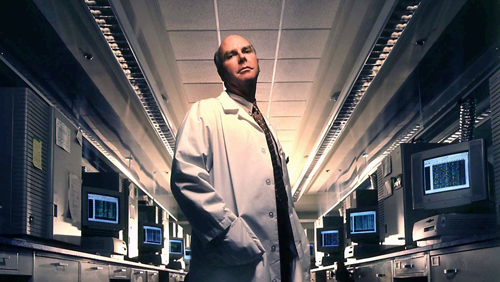
"The Matrix" does not resemble?
Craig Venter is an eccentric millionaire and a distinguished geneticist who, however, enjoys the fame of an adventurer. True, he was able to compete with the official project of deciphering the human genome and was the first to offer everyone a decryption service for money. His idea is a fix - to patent all genetic technologies.
It was not possible to patent the human genome, and under pressure he had to transfer his data to a state project. However, in 2000, Venter presented the first map of the human genome to President Clinton.
Now he is trying to patent more affordable things - for example, in 2010 he synthesized a fully artificial bio-synthetic organism capable of reproduction. The first artificial organism in history was named Cynthia.

The first artificial form of life was blue.
The name of Craig should be remembered, as it turned out that it was his genome that was one of 21 DNA samples, of which 5 were taken to decipher the human genome. As far as Venter himself selected and supervised everything, I’m not afraid to assume that it was he who became for science "the reference human genome" not worse than the Paris standards of the meter and kilogram.
But all this was a decade ago - now the equipment for genetic research and engineering has become available for the mass market, and even the Chinese show their achievements.
In 1995, scientists from Massachusetts forced the mouse to grow a human ear on its back. Unfortunately, the public did not appreciate the achievement and the mouse became the key argument on the posters of the fighters against genetic engineering.

Welcome to the beautiful new world.
In 1999, silk sheep were the loudest genetic sensation. In the Canadian NEXIA BIOTECHNOLOGIES, the corresponding gene of spiders was transplanted to ... sheep and they began to produce silk in their milk, it only remained to be separated in centrifuges.
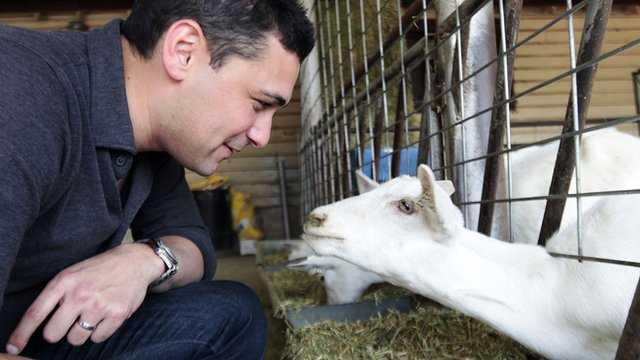
Professor Randy Lewis talks with his creation for a BBC report
In 2009, scientists at Seoul State University decided to transplant the gene of fluorescent jellyfish to puppies and they really began to glow red in the dark.
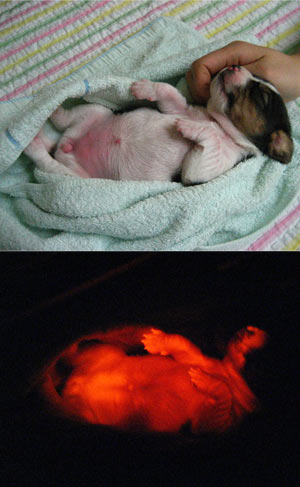
This is definitely not lost.
On November 2, 2012, a historic event happened - the first genetic device appeared on the European market - “Gleiber” is an artificially created virus that infects muscle cells with a workable copy of the damaged gene that causes “genetically caused pancreatitis.” They are sick every millionth inhabitant of the planet.
But for us the most important has become different. In 2006, the wife of Sergey Brin founded his 23andme startup (named for the number of chromosomes) - the first service to receive DNA samples by mail and to establish susceptibilities to diseases. After two years of work, Time magazine called this project “the invention of the year.”

Sergey Brin and his wife Anna Wojitsky at a party in honor of the Time award.
Ideally, our PrimerLife certainly goes back to the 23andme, but takes into account all its flaws. First, global research bases are used, not just the American ones, as does the 23andme - for example, service will always give Europeans a predisposition to obesity, because in the USA even a slight excess of weight is considered obese.
Secondly, the list of diseases is much wider and constantly updated - the authors of the project constantly monitor publications on genetics and in the case of a new study, immediately add it to the system and analyze all users using it. Thus, users constantly receive new data and updates on their genome.
Thirdly, PrimerLife immediately connects users with doctors. This may not seem important, but here lies the main problem of genetic analysis - genetic specialists to work with it are very few. In Russia, there are only 160 (!) Geneticists and they need to make an appointment, wait in line for a long time and wait for a response even longer. The site brings this process to automatism - it’s certainly better to come to the doctor personally, but in general nothing prevents you from getting ready recommendations from him directly on the site.
And in the fourth - everything is outsourced, PrimerLife does not hold its laboratories, scientists and doctors - the project only brings customers together with all the necessary specialists. The truth here lies one problem - Russian legislation strictly limits both the use of genetic technologies and the transfer of biomaterials. As a result, everything is possible with us, but too expensive - analysis instead of $ 299 in the United States will cost $ 1000 in Moscow. In the future, PrimerLife plans to solve this problem simply by building its own laboratory, maybe right in Skolkovo Technopark.
Now the project is at the stage of beta-testing and will be released early next year, you can become the first of its participants leaving your contacts on the site now. When the project is working, I will gladly spit them in a jar and write a post about the results.

The second project I met was Indoorgo - the Ekaterinburg team developing an application for smartphones that provide indoor navigation, which is very different from the external navigation that many are used to. The guys came from Yekaterinburg to submit reports on the next tranche, but there are not enough papers - the head of the it-cluster personally tested the prototype.
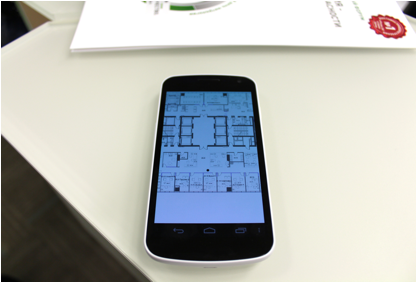
Does the prototype map the black dot? Get the next tranche
I didn’t think about such a problem at all, but there are really great prospects behind it - the branded app of the shopping center will skillfully guide visitors to the places they need. In the parking lot - to find your car, and in a museum or shop - exhibits or boutiques, and also to display their description on the screen. After all, the lack of navigation «indoor» breaks all the dreams of developers about this augmented reality like google glass or nokia city lens .
Remember how car navigators changed the world. Indoor navigation can lead to more significant changes. After all, city dwellers spend

I torment with questions of inaccessible developers
Navigation is carried out on Wi-Fi points (in the case of Indorgou only one is enough) using their own algorithm, which programmers can only say that it is more efficient and accurate counterparts, including Google maps and the alliance, which included Nokia. These companies have been developing since 2004, but their applications require additional equipment and devices. In contrast to this data, it is worth noting that in the Indorgou NS, in just 9 months, they wrote an algorithm and created an almost exactly working prototype that doesn’t need additional equipment, only a Wi-Fi access point. With such speed, they are quite capable of overtaking Google and other competitors who have spent years developing and have received much worse results. Of persistence, Indoorgo even rewrote the Wi-Fi Android driver in order to achieve maximum positioning accuracy. But it turned out that the increase in accuracy is so small that the game is not worth the candle.
It should be noted that the system really works quite precisely - I saw it in action in the Skolkovo office on the
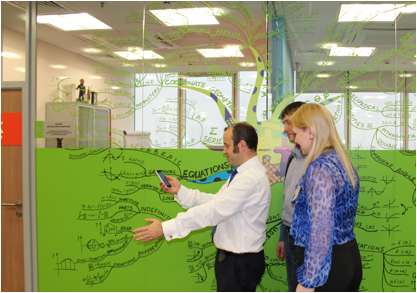
IT cluster director Albert Efimov personally tests the prototype.
Developers are so proud of their system that they are ready to arrange a Challenge for the Habr — those who can most closely guess the truth about how their system works — they are ready to take on a job with a salary that “allows you not to look back at job offers from Western IT corporations” . While their office is in Yekaterinburg, but if there are five people from Moscow, they are ready to open their representative office in the capital. Now they need testers, software engineers for Android of the first category and one senior software engineer of the first category.
If we talk about the role of the technopark, then it is key in the project - if not for the management of the technopark that constantly spurs the team, our developers would have been able to launch the project. Moreover, Technopark helps only with external management - paperwork, deadlines, etc. The rest of the project itself decides - for example, out of two million last tranches, the team decided to spend one and a half on salaries. The total amount of the grant received was the maximum amount for Skolkovo - one million dollars.
The only negative is that Indoorgo is not yet a resident of the technopark; therefore, it cannot use its equipment. What is the way the guys are pretty sad - the radio laboratory would be very useful for them, but instead of the available Skolkovo, they have to get out themselves. The reason for this injustice is trivial - it is costly to transport families to Moscow, but there is no housing (yet?) In the technology park. So you have to work in Yekaterinburg, maybe by recruiting staff in Moscow, they will be able to open their office in a technopark - everything depends on you, dear readers.
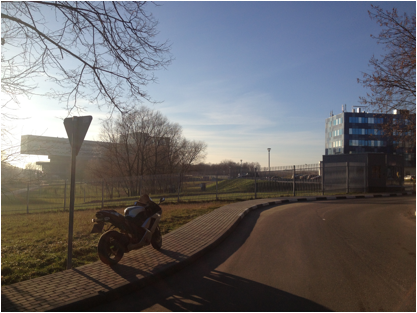
Atomsphere innovation, what I saw it.
Source: https://habr.com/ru/post/161325/
All Articles